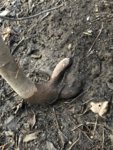barguy8194
Yamadori
I’m getting into this year and collection time is approaching. I’m in northern New Hampshire (USA) and I’ve decided that (with the exception of playing with Sequoiadendron giganteum (Giant Sequoias) because... well, I want to... ) I only want to work with species native to my home range (50 or so miles radius).
That leaves me with a couple options that I know will make interesting pieces, but from my reading, many are difficult to work with in some way.
Here’s what I’ve mostly narrowed it down to:
- Yellow and paper birch (betula alleghaniensis and papyrifera)
- sugar, silver, and red maple (Acer saccharum, saccharinum, and rubrum)
- eastern white and red pine (Pinus strobus and resinosa)
- red, white, and black spruce (Picea rubens, glauca, and mariana)
- Eastern white cedar (thuja occidentalis)
- balsam fir (abies balsamea)
- common and creeping juniper and eastern red cedar/red juniper (juniperus communis, horizontalis, and virginiana)
- eastern hemlock (tsuga canadensis)
- white ash (fraxinus americanus)
- red and white oak (quercus alba and rubra)
There are several others (a couple cherries, black walnut, some willows, tamarack/larch) and this is by far not a comprehensive list, but there’s a pretty good list.
Any “masters” want to pick a couple from the list and make suggestions about which ones to avoid?
That leaves me with a couple options that I know will make interesting pieces, but from my reading, many are difficult to work with in some way.
Here’s what I’ve mostly narrowed it down to:
- Yellow and paper birch (betula alleghaniensis and papyrifera)
- sugar, silver, and red maple (Acer saccharum, saccharinum, and rubrum)
- eastern white and red pine (Pinus strobus and resinosa)
- red, white, and black spruce (Picea rubens, glauca, and mariana)
- Eastern white cedar (thuja occidentalis)
- balsam fir (abies balsamea)
- common and creeping juniper and eastern red cedar/red juniper (juniperus communis, horizontalis, and virginiana)
- eastern hemlock (tsuga canadensis)
- white ash (fraxinus americanus)
- red and white oak (quercus alba and rubra)
There are several others (a couple cherries, black walnut, some willows, tamarack/larch) and this is by far not a comprehensive list, but there’s a pretty good list.
Any “masters” want to pick a couple from the list and make suggestions about which ones to avoid?


